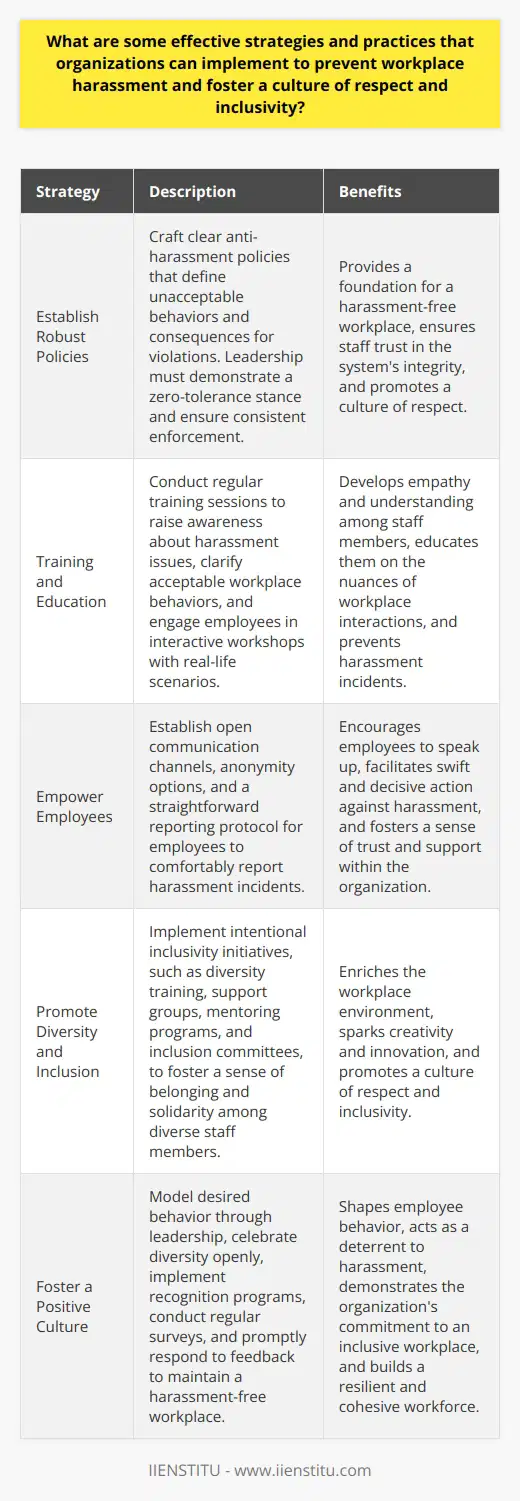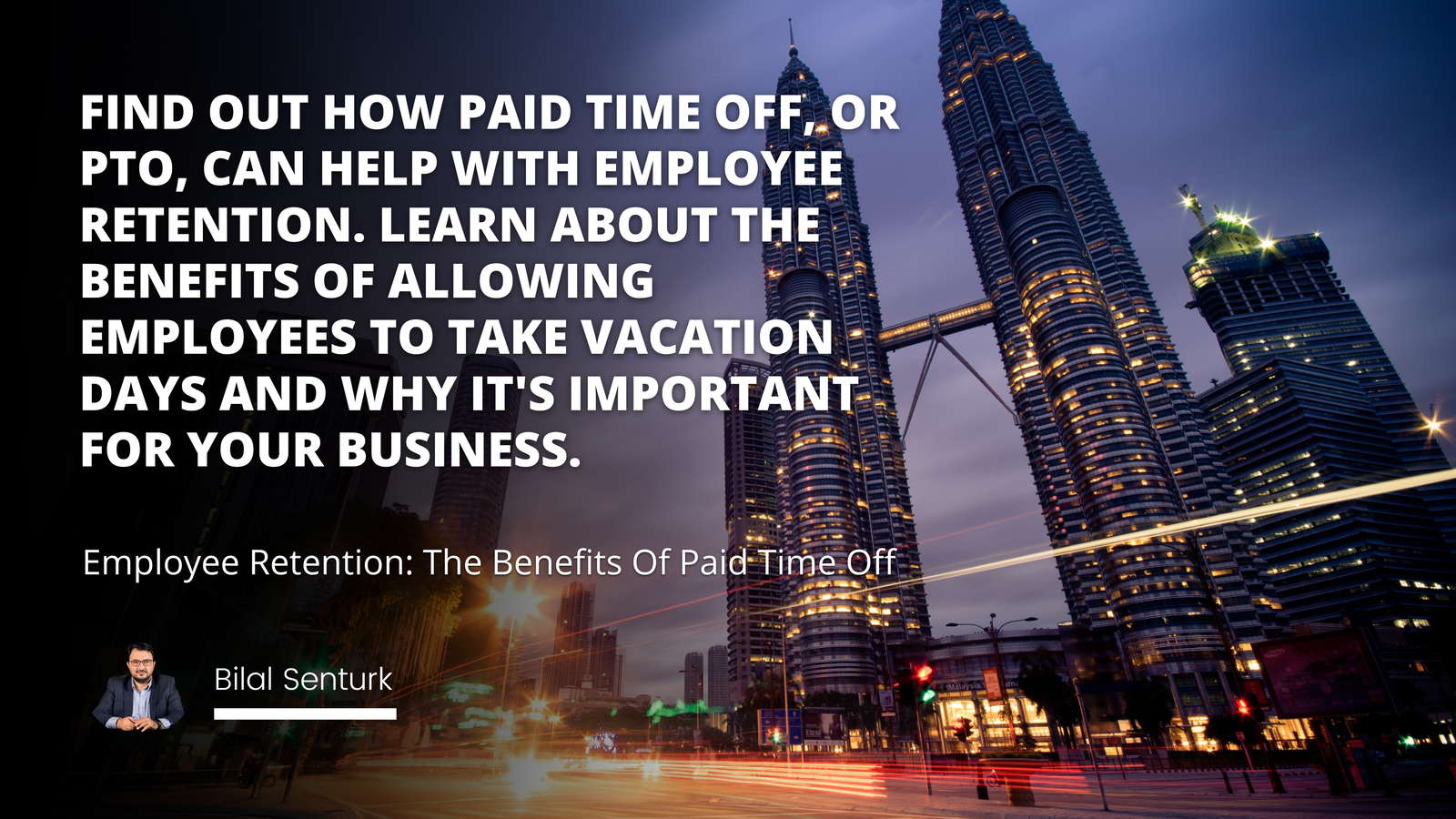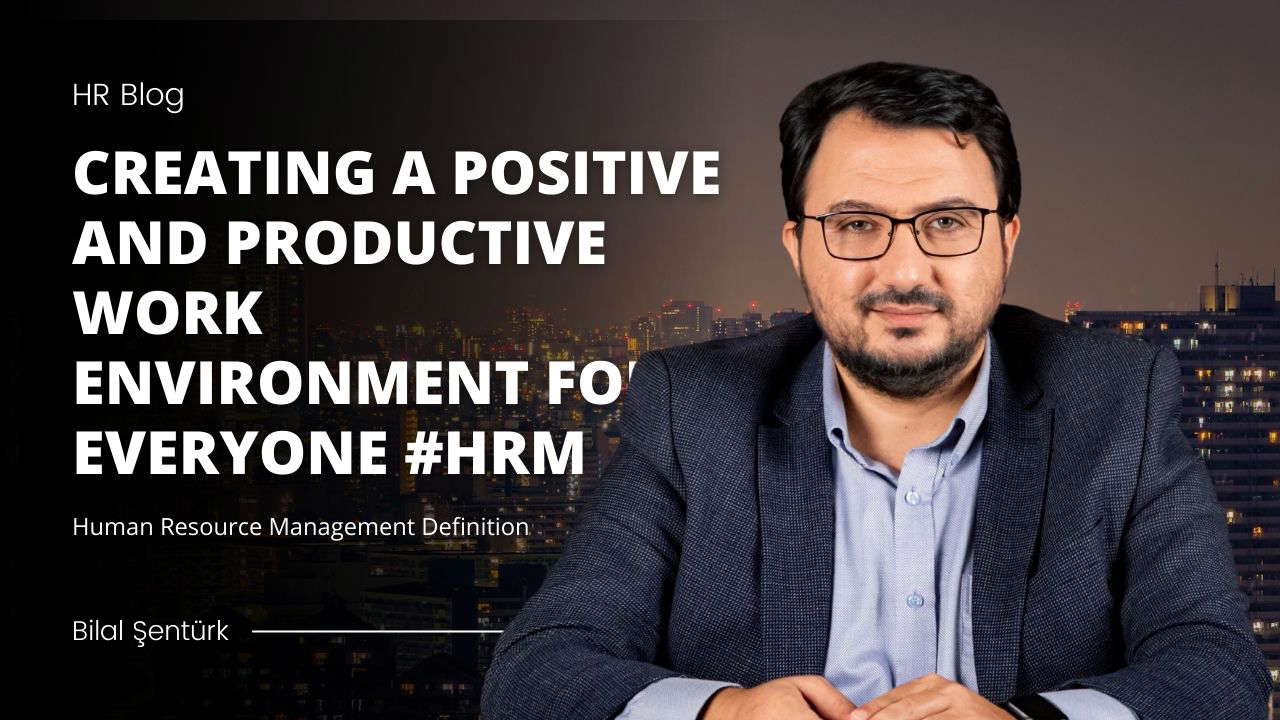
In today's dynamic workplace environments, the emphasis on a safe and respectful working atmosphere has never been more crucial. Workplace harassment remains a persistent issue that adversely affects individuals, businesses, and work culture. This article seeks to dissect the intricacies of workplace harassment, encompassing its definition, types, effects, legal landscape, and the measures that can be implemented to prevent it.
The discourse will be substantiated with relevant examples and an expert examination of the strategies that companies and individuals can adopt to foster a harassment-free workplace. A particular focus will be given to the importance of hr certification course and certificate courses online in equipping professionals with the requisite knowledge to effectively address these challenges.
Understanding Workplace Harassment
Definition and explanation of workplace harassment
Workplace harassment is an unwelcome conduct based on race, color, religion, sex (including pregnancy), national origin, age (40 or older), disability or genetic information that creates a hostile, offensive, or intimidating working environment. Harassment becomes unlawful when enduring the offensive conduct becomes a condition of continued employment or the conduct is severe or pervasive enough to create a work environment that a reasonable person would consider intimidating, hostile, or abusive.
Different types of workplace harassment
Multiple facets of workplace harassment exist, each with its characteristics and implications. Among these types are:
Physical Harassment
Physical harassment typically involves unwanted physical contact, such as hitting, pushing, or other aggressive gestures, which can create an unsafe work environment.
Verbal Harassment
Verbal harassment includes derogatory comments, jokes, or slurs that are meant to demean or belittle an individual. This form of harassment can erode a person's sense of dignity and self-worth.
Sexual Harassment
Sexual harassment encompasses unwelcome sexual advances, requests for sexual favors, and other verbal or physical harassment of a sexual nature. It can happen to individuals of any gender and is not limited to a scenario involving a supervisory relationship.
Psychological or Emotional Harassment
This is a subtle form of harassment that may include constant criticism, manipulation, or attempts to demean an individual's contributions, undermining their confidence and emotional stability.
Examples of workplace harassment situations
Example scenarios of workplace harassment include a supervisor making derogatory remarks about an employee's race, an employee showing inappropriate images to coworkers, or a pattern of undermining a colleague's ideas without justification, detrimental to their professional standing.
The Effects of Workplace Harassment
Analysis of the effects on the individual
The ripple effects of workplace harassment on an individual's physical and mental health are profound and multilayered.
Psychological Effects
Victims often suffer from stress, anxiety, and in severe cases, post-traumatic stress disorder (PTSD), which can lead to extended psychological therapy and medication.
Emotional Effects
The emotional turmoil can manifest as depression, loss of sleep, and a significant drop in self-esteem, often impacting personal relationships and overall quality of life.
Consequences for the workplace environment
An environment riddled with harassment can become toxic, significantly impairing the organizational well-being.
Loss of productivity
When employees are focussed on navigating a hostile work environment, their productivity plummets, as they are unable to function to the best of their abilities.
Increased absenteeism
Victims may resort to taking more days off to avoid harassment, leading to increased absenteeism, which in turn affects the workflow and deadlines.
The financial impact on businesses
Apart from ethical considerations, there is a tangible monetary impact on companies. Legal fees, settlements, and the cost of replacing employees who leave due to harassment contribute to considerable financial losses. Harassment also tarnishes a company's reputation, possibly leading to a downturn in business opportunities and profits.
Legislation and Regulations Addressing Workplace Harassment
Overview of laws designed to tackle workplace harassment
Countries have enacted various laws designed to prevent workplace harassment. In the United States, the Civil Rights Act, Americans with Disabilities Act (ADA), and the Age Discrimination in Employment Act (ADEA) are a few examples of federal laws that address workplace discrimination and harassment.
Employee Rights under these laws
Employees have the right to work in an environment free from harassment and can seek legal recourse if subjected to it. Recourse can range from internal complaints to external legal action.
Employer responsibilities and liabilities
Employers are legally obligated to provide a safe working environment. This includes implementing effective policies, conducting prompt investigations when complaints arise, and taking appropriate disciplinary action against offenders.
Reporting and Dealing with Workplace Harassment
Steps to report workplace harassment
There are typically two paths available for victims reporting harassment at work:
Informal Complaint
The first step often involves communicating issues to a supervisor or an HR representative, seeking resolution through informal channels.
Formal Complaint
If the harassment persists, or if informal complaints are not appropriately addressed, formal complaints might be filed, which often initiates a formal investigation process.
How to deal with workplace harassment as a victim
Victims are encouraged to document instances of harassment, seek support from trusted colleagues or professionals, and understand their rights under the law. Hr certification course or certificate courses online can provide individuals with knowledge regarding appropriate responses to such incidents.
How employers should handle reported incidents
Employers should follow a standardized procedure for handling harassment complaints that protects the confidentiality of the victim while ensuring a thorough investigation. Swift and fair action is crucial to maintain a sense of justice and deter future incidents.
Preventing Workplace Harassment
Importance of preventative measures in the workplace
Preventative measures are essential to reduce the incidence of workplace harassment. These measures serve not only to protect individuals but also to establish a positive organizational culture.
Educating employees and promoting awareness
An organization must educate its workforce about what constitutes harassment and the protocols for reporting it. Enrolling employees in hr certification course or providing certificate courses online can be effective in raising awareness and equipping them with tools to prevent and address harassment.
The role of a healthy and respectful workplace culture
Building a culture where respect and integrity are core values dissuades potential harassers and empowers victims to speak up. Leadership plays a pivotal role in modeling appropriate behavior and supporting anti-harassment policies.
Recap of the importance of recognizing, addressing, and preventing workplace harassment
Recognizing and addressing workplace harassment is not only a legal imperative but also a moral one. The consequences of ignoring such inappropriate behavior can be profound, affecting individuals, altering workplace dynamics, and causing financial ramifications for businesses.
Frequently Asked Questions
What are the various forms of workplace harassment and how do they impact an individual's mental and physical health?
Forms of Workplace Harassment
Workplace harassment appears in various forms. Each affects individuals uniquely. It creates toxic environments. It's crucial to recognize these forms. Eradication can then become possible.
Verbal Harassment
Words wield immense power. Verbal harassment includes insults, slurs, and mockery. Derogatory comments about race, gender, or religion also feature prominently. These actions intimidate and belittle targets. They erode self-esteem. They damage professional reputations.
Physical Harassment
This harassment involves unwanted physical contact. It can range from seemingly innocuous actions to violence. It includes patting, hugging, or hitting. Victims often experience immediate physical harm. Psychological effects may be long-lasting.
Sexual Harassment
Sexual harassment is widespread. Unwanted advances and comments fall into this category. So do gestures and displays of inappropriate material. Victims often face severe emotional distress. They may feel violated and unsafe at work.
Cyber Harassment
Technology enables cyber harassment. This occurs through emails, social media, or messaging. Information spreads rapidly online. Cyber harassment often happens outside the workplace. Yet, it severely affects the work environment.
Discriminatory Harassment
Different from but related to verbal harassment is discriminatory harassment. It targets immutable characteristics. These can include age, disability, or ethnic background. It reinforces systemic biases. It marginalizes specific groups.
Retaliation
This form punishes individuals for certain actions. It follows complaints or whistleblowing. The harasser aims to intimidate. They discourage further complaints. Fear of retaliation can silence many.
Psychological Harassment
Bullying and emotional manipulation are common examples. These behaviors undermine confidence. They foster an atmosphere of fear. Complexity often surrounds their recognition.
Impact on Mental and Physical Health
The effects of harassment are profound. They permeate both personal and professional lives.
- Stress levels increase.
- Victims face anxiety and depression.
- Eat and sleeping patterns may change.
- Concentration often declines.
- Harassment triggers post-traumatic stress disorder (PTSD).
- Long-term exposure leads to chronic health issues.
- Individuals might develop high blood pressure or heart disease.
The burden often extends beyond the individual. Colleagues who witness harassment also suffer. They may feel helpless. They fear becoming targets themselves.
Conclusion
Addressing workplace harassment is vital. Understanding its forms is the first step. Action must follow recognition. Employers bear responsibility for creating safe environments. Victims need support and avenues for redress. Society benefits when all workplaces commit to zero tolerance.
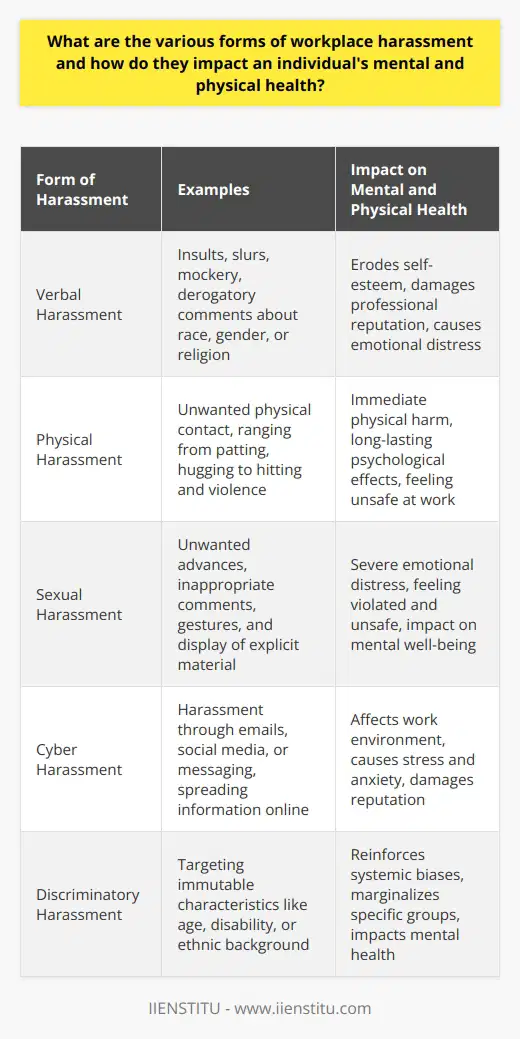
What legal protections and remedies are available to victims of workplace harassment in the context of U.S. employment law?
Workplace Harassment and Legal Protections
Understanding Workplace Harassment
Workplace harassment extends beyond mere nuisance. It introduces a hostile, abusive, or intimidating environment. Such conduct disrupts work and undermines the victim’s well-being. I will detail the legal remedies available to victims under U.S. employment law.
Federal Protections
Title VII of the Civil Rights Act of 1964 stands tall. It prohibits harassment based on race, color, religion, sex, and national origin. The Equal Employment Opportunity Commission (EEOC) enforces these laws.
The Age Discrimination in Employment Act (ADEA) shields workers 40 and older. It disallows harassment based on age.
The Americans with Disabilities Act (ADA) renders harassment due to disability unlawful.
Filing a Complaint with the EEOC
Victims must first file a complaint with the EEOC. The Commission will then investigate the claims. If they find evidence of harassment, they can mediate a settlement. They may also file a lawsuit on the victim’s behalf.
State Laws and Protections
States often extend protections further. They may prohibit harassment based on sexual orientation, gender identity, or other traits.
Remedies and Settlements
Remedies can range widely. They may include:
- Reinstatement of the victim’s job
- Back pay and benefits recovery
- Compensation for emotional distress
- Punitive damages for egregious cases
- Attorney's fees and litigation costs
Settlements may offer a similar range of compensation.
Employer Liability and Preventative Measures
Employers bear responsibility for preventing and addressing harassment. They must create policies against harassment. They must investigate complaints promptly and thoroughly. Failure to do so may increase their liability.
Harassment Training and Education
Many employers provide training to prevent workplace harassment. They educate employees on what constitutes unacceptable behavior. They also explain the complaint process.
Retaliation Protections
Retaliation against an individual who complains of harassment is illegal. Strong laws deter such acts.
Seeking Legal Advice
Victims can seek counsel from attorneys specializing in employment law. These professionals can navigate the complex legal system. They offer advice, represent in negotiations, and litigate if necessary.
Conclusion
Legal remedies for workplace harassment are robust but require prompt action. Knowledge of rights and procedures is crucial. Victims should not suffer in silence. They can take legal action to remedy their situation and hold offenders accountable.
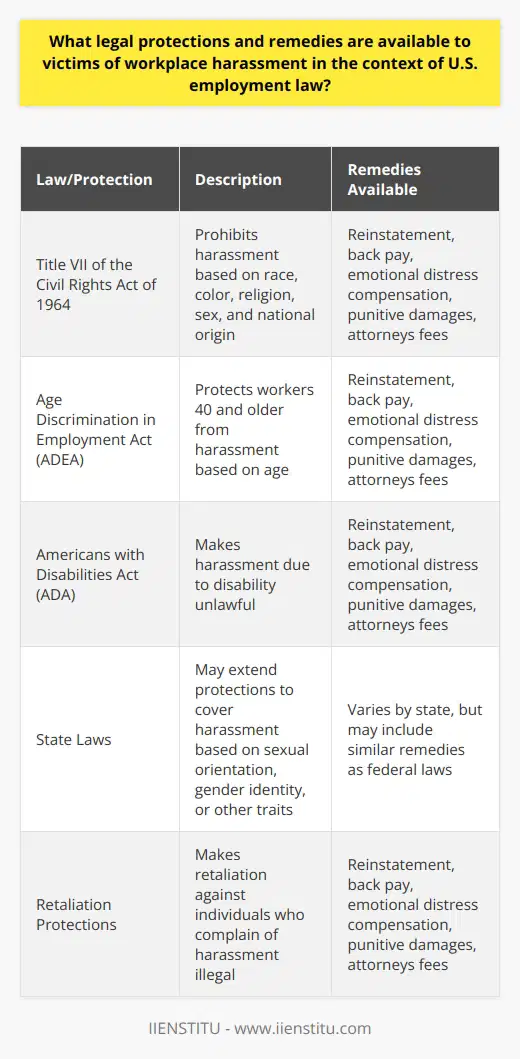
What are some effective strategies and practices that organizations can implement to prevent workplace harassment and foster a culture of respect and inclusivity?
Preventing Workplace Harassment
Organizations seek to maintain productive, respectful work environments. Harassment undermines these efforts significantly. It causes distress and prompts inefficiencies. To address this, companies must adopt proactive strategies. These strategies should focus on prevention and inclusivity.
First, policy development is crucial. Organizations must craft clear anti-harassment policies. These guidelines should define unacceptable behaviors explicitly. They must also detail consequences for policy violations.
Establish Robust Policies
Leadership plays a vital role in policy enforcement. They must demonstrate a zero-tolerance stance. Consistent enforcement is essential. Staff members must trust the system's integrity.
Training and Education
Regular training sessions are indispensable. They raise awareness about harassment issues. Training also clarifies acceptable workplace behaviors. Staff must understand the nuances of workplace interactions.
Interactive workshops are particularly effective. They engage employees in real-life scenarios. Such activities develop empathy and understanding.
Empower Employees
Open communication channels are necessary. Employees should feel comfortable reporting incidents. They need to know their voices count. Anonymity options can facilitate this process.
Employers should establish a straightforward reporting protocol. Staff must know exactly where to turn. They must understand the process thoroughly. This transparency aids in swift, decisive action against harassment.
Promote Diversity and Inclusion
A diverse workforce enriches the workplace environment. It sparks creativity and innovation. Inclusivity initiatives should be intentional. They must exceed token gestures.
Diversity training can be integral to these initiatives. It educates employees on cultural sensitivity. It makes staff members consider their own biases.
- Support groups
- Mentoring programs
- Inclusion committees
These can all foster a sense of belonging. They encourage solidarity among diverse staff members.
Foster a Positive Culture
Organizational culture shapes employee behavior. A culture of respect is vital. It acts as a deterrent to harassment.
Leaders must model the desired behavior. They should celebrate diversity openly. Recognition programs can highlight these values. They signal the importance of an inclusive workplace.
Regular surveys can gauge workplace sentiment. They can uncover issues before they escalate. Prompt responses to such feedback are imperative. They demonstrate the organization's commitment to a harassment-free workplace.
Continuous Improvement
Finally, organizations must embrace continuous improvement. They cannot grow complacent. Laws change. Societal norms evolve. Company policies and practices must adapt accordingly.
Internal audits are helpful. They reveal the strengths and weaknesses of current strategies. External consultants can offer fresh insight. They can guide the refinement of harassment prevention practices.
In conclusion, a multi-faceted approach is necessary. It requires robust policies, education, empowerment, and culture shaping. These elements work in concert to maintain a respectful and inclusive workplace. They make effective strategies against workplace harassment. They build resilient, cohesive, and productive organizations.
